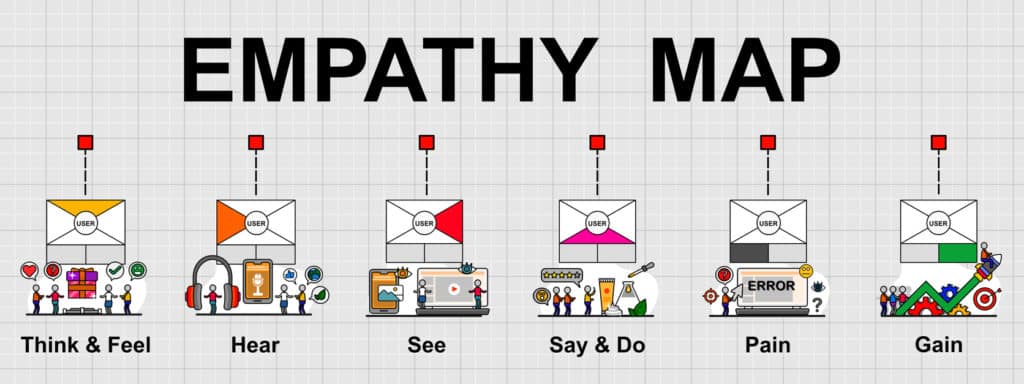A primary element of the Design Thinking process, Empathy, helps an individual think of creative yet out-of-the-box solutions to resolve conflicts, build more productive teams, and improve relationships with clients/customers. Ironically, while most professionals are confident about learning new things, they usually know barely anything about Empathy. You can often find them struggling with questions like – What is Empathy? Why is it a primary part of Design Thinking that works for people?
In the article below, let’s discover what Empathy means and how lacking it can result in product failure.
What is Empathy?
In simple words, Empathy is the ability to see the world through the eyes of another person and understand their perspective on a situation. Empathy enables a person to use those insights to improve someone else’s mood and support them through challenging situations.
The first stage of Design Thinking, Empathy helps to gain a deeper understanding of the problems and realities of the target audience. It also involves assessing the difficulties people face and uncovering their latent needs and desires. Empathy also helps to understand how this product/service impacts lives, specifically within the contexts being investigated.

Also Read: How Design Thinking can be Used in Uncertain Times
Empathy Methods
Let’s be honest here – developing Empathy can be a struggle. The best way to excel at this stage is to effectively put aside the personal viewpoint and see things from the other person’s perspective. Over and above that, start practicing the following techniques to make Empathy your second nature.
1. Give 100% Attention
So to empathize, you should carefully listen to what someone is trying to say. Keep on taking notes of all the keywords and phrases that they continuously use. Then, notice how & what they are saying. What is their tone? Are they scared, angry or ashamed? Avoid counter questioning, or saying disputing facts at this stage.
2. Keep Your Ego at Bay
Often at the workspace, professionals are asked to adopt egocentric views and be firm in their opinions and thoughts. However, to empathize deeply, they need to put their ego aside and work on the primary goal, which is to understand the feelings of others.
3. Hone Your Observation Skills
To develop Empathy, one needs to act more than listen. One needs to observe others and closely observe their behaviors, subtle indications, non-verbal expressions, body language, and environments. At times, what the user articulates is only a fraction of the full story. By honing observation skills, one can have a better understanding of someone else’s experience.
Another thing that can be done is to read and interpret the signals that the users give off via their body language to connect on a deeper level. These skills come with practice because at times a body language can be so subtle like eyebrow movement, placement of hands, etc. that is only visible to the practiced readers of body language. Mentioned below are some of the essential things that you should give attention to:
- Try to listen to what’s not being said, avoided or covered
- Keep on eye on phrases that encourage more expression or lead the conversation or story
- Know how to ask it and what to ask and when the person is ready to give you the answer.
4. Consider the perspective of other people
So when I say this, the first quote that comes to my mind is – Before you criticize someone, walk a mile in their shoes. Keep an open mind and do not emphasize your assumptions as it does not leave much space for Empathy. Once the other person tries to convince you about their point of view, you can acknowledge it. But this does not mean that you have to agree with it. Try not to get into a debate or an argument, and show some respect by listening. When in doubt, invite the other person to describe their position and ask them how they might want to resolve that issue.
5. What-How-Why Method
A What-How-Why method is a tool used to observe people and gets a deeper level of understanding. The concrete technique of observation starts with asking— What— and from there, one keeps moving to higher abstraction levels— asking How — and then finally asking Why. Once that is done, you should divide your observation into three sections.
- What: In this section, note the details of what is happening? What is the background?
- How: Here, you can describe the emotional impact of performing the task.
- Why: Try to interpret the scene based on the observation.

Conclusion
Would you like to improve/master empathy and also the other five stages of Design Thinking? Secure your seat in the Design Thinking Program and upskill today.




